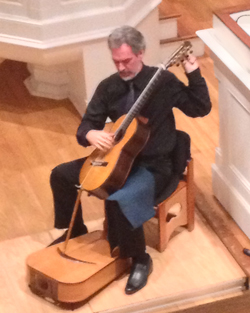by Daniel Hathaway

Galbraith explained the origins of the instrument in an interview with this publication in 2012.
I was aware of some of the limitations that the 6-string guitar imposes early on, in fact as early as when I was twelve, when learning my first Bach lute suite. When facing that material on guitar, you’re confronted with having to make decisions and compromises: you don’t have the necessary range to play what Bach writes, so you have to rearrange things to fit. And it struck me even then: why don’t we have a wider-ranging instrument to play this great repertoire? Soon after, the same questions arose when playing the lute music of Dowland. Meanwhile, there were one or two prominent players who used instruments with a wider range.
Anyway, I kept the idea in the back of my mind, until one day it really became inevitable for me that a guitar with a wider range would better cope with the entire repertoire. It’s not just a question of the lute repertoire, or even transcriptions: much of the original guitar repertoire, even by such central repertoire composers as Rodrigo, Tedesco, and Henze, pushes the guitar to new limits, which frequently lie beyond the natural scope of the six-string instrument.
Because it boasts an extra pair of strings, the instrument inspired Galbraith to reinvent his playing style.
I’d already previously played six-string guitar for years in a vertical position, which allowed for a wider range of technical options than those normally available in the standard guitar posture, using a footstool or equivalent. Things like a ready, open stretch available at any given moment to the left hand, and access to what Kreisler called “the lungs of the string player — the free wrist” in the right hand. So when the eight-string was finally ready, I dived straight in, feeling that I was still basically dealing with those same technical challenges that I had already been facing since I changed posture, only now extended to a wider set of coordinates.
In addition to playing the instrument in a cello-like position, Galbraith also introduced an end pin and a resonance box into which the end pin fits, “designed to further enrich the sound and volume of the guitar.”
I knew Rubio would probably produce an instrument with his typical rich sound — he always was incredibly consistent — but I hadn’t reckoned on quite how rich he would go with the sound of this new project! The resonance box simply enhances and subtly amplifies what’s already there. It also helps smoothen out any rough edges. My second Rubio eight-string initially had a rather bright-sounding first string, for instance, which the resonance box helped mitigate. The box gives a feeling similar to that of releasing the soft pedal on a good piano: with the box, you have a fuller resonance, one that seems more complete.
Because of Paul Galbraith’s travel schedule, a telephone interview was difficult to schedule, but the guitarist graciously agreed to answer a few questions by email about the arrangements he’ll play on March 17th.
Daniel Hathaway: In a previous interview with ClevelandClassical.com, you said, “Mozart is notoriously difficult to transcribe, not just for guitar. He was a very instrumentally-aware composer.” Does the same apply to Haydn, or is his music a different animal?
Paul Galbraith: There are two distinct composer types: the ones who are instrumentally “invested,” and the ones who aren’t, or aren’t especially. Bach was the most obvious example of the latter type. And Haydn belongs there too. Mostly, when Haydn wrote for keyboard, he used it as his musical “workshop” as he called it, bringing in ideas, textures, echoes from string quartets, orchestra, wind band, and so on, something Beethoven famously espoused also in much of his piano writing. It was only in certain of the late piano sonatas that Haydn, writing for specific pianists, composed in a more consciously virtuosic, pianistic style. Those aside then, the answer is yes, for the bulk of his sonatas, Haydn is far easier to transcribe than Mozart, given this fundamentally different compositional attitude.
DH: Scriabin’s piano music (I like to describe it as “highly perfumed”) must also pose some challenges for a transcriber. Can you talk a bit about that process?
PG: With Scriabin, you have to choose carefully and wisely, otherwise you can end up with transcriptions which sound cumbersome and unconvincing. Here was a composer of the instrumentally “invested” type and, like Mozart, a virtuoso pianist. But having said that, there are a few Preludes, especially from his early Chopin-inspired period, which sound remarkably idiomatic on guitar. I’m not sure quite why they work so well, but I’m very glad they do. Of the ten or so that I’ve arranged so far, I’ve chosen four for this program.
DH: You’re also playing some transcriptions of piano music by Albéniz. How do those come off differently with the 8-string instrument — have you had to do a bit of rearranging there as well?
PG: Yes, I went back to the piano originals and re-thought the transcriptions entirely: different keys, different approach. Guitarists are often a little taken-aback when they hear them, because we’ve become accustomed to the traditional guitar versions by now. And the traditional guitar versions do work wonderfully too, on their own terms. But I’m enjoying playing these arrangements which stick closely to what Albéniz wrote in the first place: particularly, there are details of texture and dynamics which make new sense.
Tickets to Paul Galbraith’s recital are available online.
Photo by Erik Mann.
Published on ClevelandClassical.com March 13, 2018.
Click here for a printable copy of this article



